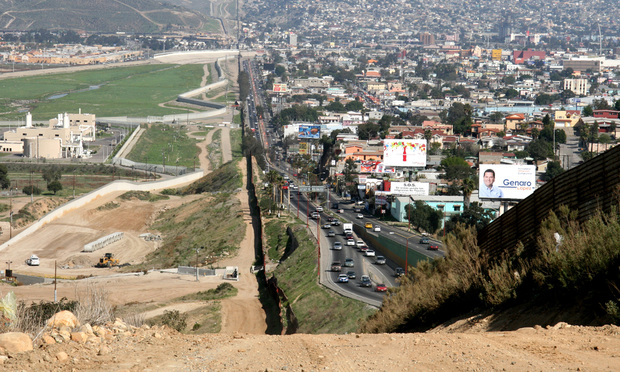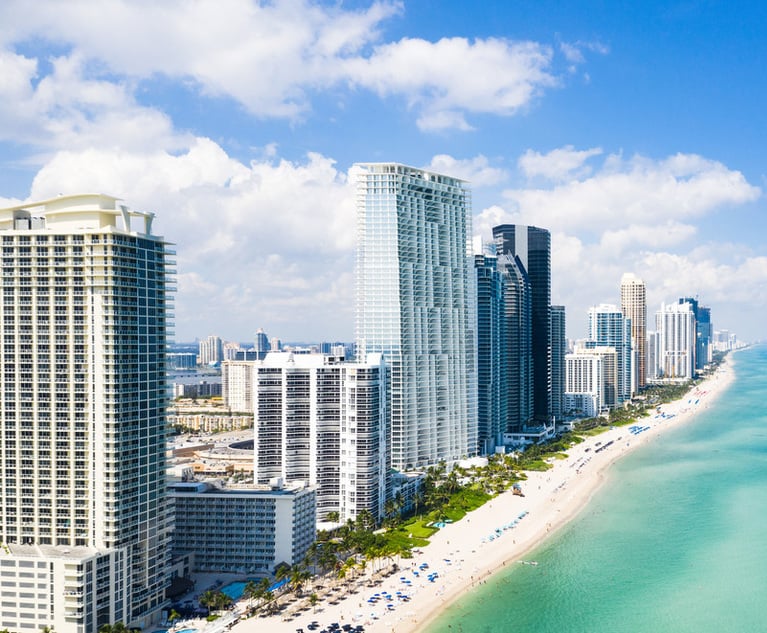What Really Happens When Migrants Arrive at US Border
For many people trying to enter the country, it's a matter of waiting, waiting and waiting some more for the OK to come across, unless they try to force the issue and slip over the border.
June 27, 2019 at 10:20 AM
7 minute read
 A small fence separates densely populated Tijuana, Mexico, right, from the United States in the Border Patrol's San Diego Sector. Construction is underway to extend a secondary fence over the top of this hill and eventually to the Pacific Ocean. Credit: SFC Gordon Hyde/wikipedia
A small fence separates densely populated Tijuana, Mexico, right, from the United States in the Border Patrol's San Diego Sector. Construction is underway to extend a secondary fence over the top of this hill and eventually to the Pacific Ocean. Credit: SFC Gordon Hyde/wikipedia
The harrowing photo of a drowned toddler and her father along the Rio Grande has illustrated the risks migrants are willing to take to reach the U.S., even as increasingly hard-line policies by President Donald Trump's administration aim to keep them out.
For many people trying to enter the country, it's a matter of waiting, waiting and waiting some more for the OK to come across, unless they try to force the issue and slip over the border, a dangerous and sometimes lethal undertaking that involves trekking through the scorching desert and fording the deceptively tricky Rio Grande.
Here is a look at how migrants try to reach the U.S. and what they encounter:
TWO WAYS
Hundreds of thousands of people have been arriving at the border in recent months, many of them families fleeing violence and poverty in Central America. Once they reach the border, they can take different paths to try to get into the U.S.
One way is by presenting themselves at official border crossings, also known as ports of entry, and requesting asylum. That marks the start of an often yearslong legal process in which they have to prove a well-founded fear of persecution in their homeland.
But the Trump administration has implemented a border-wide policy that limits the number of asylum applications a border crossing accepts each day. It's known as “metering,” and it has created long lines as people wait for months on the often drug- and violence-riddled Mexican side for their chance to apply for asylum.
At the border crossing near San Diego, for example, about 80 people are handled each day. In some other cities, days go by without anyone being allowed to apply.
Various U.S. cities along the border have their own waiting lists. One recent estimate put the overall number of people waiting at 18,000.
And the waiting list isn't the only Trump administration practice keeping migrants in Mexico.
Under a policy announced in December, many migrants who have applied for asylum must then wait in Mexico while their cases wend their way through the U.S. immigration courts. The policy applies primarily to Central Americans.
Previously, many people applying for asylum were allowed to enter the U.S., where they were either detained or released into the country while their cases went through the system, a process that could take months or years and enabled some immigrants to disappear into the United States.
As a result of President Donald Trump's new policy, over 14,000 asylum applicants are waiting in Mexico while their cases are decided.
But many people get frustrated by the long wait or don't even bother with getting in line. So they take a different approach: They cross the border — secretly or openly — outside of the official crossings and turn themselves in to Border Patrol agents, who then take them into custody on the U.S. side.
In the case of the two dead El Salvadoran migrants in the photo, Óscar Alberto Martínez Ramírez and daughter Valeria, the girl's parents decided to cross the Rio Grande after waiting in Mexico for two months to apply for asylum, according to news reports. The girl's mother was not injured.
BORDER PATROL CUSTODY
When migrants who either walk or sneak across the border are apprehended, Border Patrol agents take them to facilities for processing, which includes a health screening and a criminal background check.
Because of the overwhelming surge of migrants, the Border Patrol has had to open several temporary facilities to hold and process them. Government inspectors and attorneys report that those places are extremely overcrowded.
A recent inspector general report on an El Paso, Texas, processing center found that up to 900 people were crammed into a space meant for less than 200. Some people were standing on toilets, and many said they had been there for weeks.
Immigrants refer to Border Patrol stations, usually the first place a migrant is held, as “hieleras,” or iceboxes, because they are cold, and to processing facilities as “perreras,” or dog cages, because of the fences.
People who are in Border Patrol custody are supposed to be released within 72 hours, but they are being held long past that.
WHAT ABOUT THE CHILDREN?
The government has two categories for children who come to the U.S., and they are treated differently: There are unaccompanied minors — that is, children who arrive without an adult — and there are youngsters who come to the border with their parents. Children who come with a relative but not a parent are often separated from that adult and treated as unaccompanied minors.
Unaccompanied children are supposed to be transferred to the U.S. Health and Human Services Department, which contracts with various companies and nonprofit organizations to run shelters where the youngsters can stay until a caseworker finds a suitable relative or parent in the U.S. to release them to.
But the growing number of unaccompanied minors — there were about 11,500 in May alone — has drained HHS resources, and it hasn't been able to take children in as quickly as it usually does, the agency says. That means youngsters languish in Border Patrol detention facilities for weeks. Five children have died after being taken in by the Border Patrol since December.
Lawyers who interviewed children at a Border Patrol station in Clint, Texas, described finding hungry, sick and unwashed youngsters.
As for families with children, they are typically held together as families for weeks in government custody, then set free in the U.S. to await decisions on their asylum requests. Often they are released to shelters or nonprofit organizations in border cities; sometimes they are dropped off at bus stations and forced to fend for themselves.
Church groups and other organizations have stepped in to help some of them. In Phoenix, for example, aid workers show up at the bus station and help arrange bus tickets or take migrants to a shelter.
AFTER THEIR RELEASE FROM GOVERNMENT CUSTODY
Many families set free in the U.S. go to live with relatives or friends. They are required to let Immigration and Customs Enforcement know what city they will be in, and their immigration case is transferred to whichever court is closest.
The families are expected to show up to court when they get a hearing date. Figures show that most of them do so, but the court system is so backlogged that it can take years for immigrants to have their asylum cases resolved.
Astrid Galvan reports for the Associated Press.
This content has been archived. It is available through our partners, LexisNexis® and Bloomberg Law.
To view this content, please continue to their sites.
Not a Lexis Subscriber?
Subscribe Now
Not a Bloomberg Law Subscriber?
Subscribe Now
NOT FOR REPRINT
© 2025 ALM Global, LLC, All Rights Reserved. Request academic re-use from www.copyright.com. All other uses, submit a request to [email protected]. For more information visit Asset & Logo Licensing.
You Might Like
View All
Winston & Strawn Snags Sidley Austin Cross-Border Transactions Partner in Miami
2 minute read
Miami’s Arbitration Week Aims To Cement City’s Status as Dispute Destination
3 minute read
Brazil Is Quickly Becoming a Vital LatAm Market for Greenberg Traurig, Other US Law Firms
5 minute readTrending Stories
- 1Ex-Kline & Specter Associate Drops Lawsuit Against the Firm
- 2Am Law 100 Lateral Partner Hiring Rose in 2024: Report
- 3The Importance of Federal Rule of Evidence 502 and Its Impact on Privilege
- 4What’s at Stake in Supreme Court Case Over Religious Charter School?
- 5People in the News—Jan. 30, 2025—Rubin Glickman, Goldberg Segalla
Who Got The Work
J. Brugh Lower of Gibbons has entered an appearance for industrial equipment supplier Devco Corporation in a pending trademark infringement lawsuit. The suit, accusing the defendant of selling knock-off Graco products, was filed Dec. 18 in New Jersey District Court by Rivkin Radler on behalf of Graco Inc. and Graco Minnesota. The case, assigned to U.S. District Judge Zahid N. Quraishi, is 3:24-cv-11294, Graco Inc. et al v. Devco Corporation.
Who Got The Work
Rebecca Maller-Stein and Kent A. Yalowitz of Arnold & Porter Kaye Scholer have entered their appearances for Hanaco Venture Capital and its executives, Lior Prosor and David Frankel, in a pending securities lawsuit. The action, filed on Dec. 24 in New York Southern District Court by Zell, Aron & Co. on behalf of Goldeneye Advisors, accuses the defendants of negligently and fraudulently managing the plaintiff's $1 million investment. The case, assigned to U.S. District Judge Vernon S. Broderick, is 1:24-cv-09918, Goldeneye Advisors, LLC v. Hanaco Venture Capital, Ltd. et al.
Who Got The Work
Attorneys from A&O Shearman has stepped in as defense counsel for Toronto-Dominion Bank and other defendants in a pending securities class action. The suit, filed Dec. 11 in New York Southern District Court by Bleichmar Fonti & Auld, accuses the defendants of concealing the bank's 'pervasive' deficiencies in regards to its compliance with the Bank Secrecy Act and the quality of its anti-money laundering controls. The case, assigned to U.S. District Judge Arun Subramanian, is 1:24-cv-09445, Gonzalez v. The Toronto-Dominion Bank et al.
Who Got The Work
Crown Castle International, a Pennsylvania company providing shared communications infrastructure, has turned to Luke D. Wolf of Gordon Rees Scully Mansukhani to fend off a pending breach-of-contract lawsuit. The court action, filed Nov. 25 in Michigan Eastern District Court by Hooper Hathaway PC on behalf of The Town Residences LLC, accuses Crown Castle of failing to transfer approximately $30,000 in utility payments from T-Mobile in breach of a roof-top lease and assignment agreement. The case, assigned to U.S. District Judge Susan K. Declercq, is 2:24-cv-13131, The Town Residences LLC v. T-Mobile US, Inc. et al.
Who Got The Work
Wilfred P. Coronato and Daniel M. Schwartz of McCarter & English have stepped in as defense counsel to Electrolux Home Products Inc. in a pending product liability lawsuit. The court action, filed Nov. 26 in New York Eastern District Court by Poulos Lopiccolo PC and Nagel Rice LLP on behalf of David Stern, alleges that the defendant's refrigerators’ drawers and shelving repeatedly break and fall apart within months after purchase. The case, assigned to U.S. District Judge Joan M. Azrack, is 2:24-cv-08204, Stern v. Electrolux Home Products, Inc.
Featured Firms
Law Offices of Gary Martin Hays & Associates, P.C.
(470) 294-1674
Law Offices of Mark E. Salomone
(857) 444-6468
Smith & Hassler
(713) 739-1250







